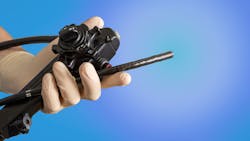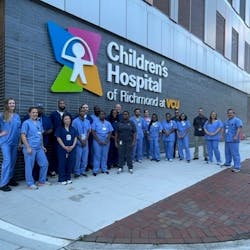VCU Health’s flexible scope processing success and the latest market innovations
When it comes to the processing of flexible endoscopes, sterile processing (SP) professionals have a broad range of resources with guidance on how to do it correctly, including the manufacturers’ instructions for use (IFU) and industry standards.
These guidelines continue to evolve, with the American National Standards Institute (ANSI)/Association for the Advancement of Medical Instrumentation (AAMI) publishing its ST91:2021 flexible and semi-rigid endoscope processing in healthcare facilities standard in March 2022, and the Association of periOperative Registered Nurses (AORN) updating its Guideline for Processing Flexible Endoscopes guideline in September 2022.
How have SP teams adapted their processes, workflows, and training to meet updated recommendations? And what are vendors offering in terms of new products/solutions to support the work of SP professionals?
Healthcare Purchasing News (HPN) presents VCU Health’s flexible scope processing success story, along with some of the latest endoscope care innovations from vendors in this space.
VCU Health: The heroes of HLD
Daniels and his team established a High-Level Disinfection (HLD) department outside of the health system’s main SP department “in response to the high volume and growing concerns of inadequate reprocessing of flexible scopes worldwide,” in his words. The HLD department has its own dedicated staff to reprocess all flexible scopes (both semi-critical and critical) alongside all other semi-critical devices, which include endocavity probes, Transesophageal Echocardiogram (TEE) probes, ophthalmology devices, etc.
Growing talent through ongoing training
Fully staffed, the VCU Health HLD department has 35 employees, including a director, manager, coordinator, supervisor, equipment technicians, and technicians. The role hierarchy—from HLD Technician Assistant to HLD Technician to HLD Senior Technician—“helps promote growth internally and provides incentives for longevity,” Daniels explained.
Equipment technicians in the department oversee all broken scopes, new scopes, and relevant equipment, and those who demonstrate success in their role are incentivized to be promoted to Biomed Technicians.
Upon hire, each new HLD department team member enters a “Grass Roots System” of training, which Daniels described step by step:
1. The first three weeks are spent outside the HLD room, at a desk completing an online course in flexible endoscope reprocessing. The team member must pass a quiz after each chapter and a final test.
2. After passing the test, the team member reviews department policies and standards.
3. Next, “the team member is ready to change into scrubs to join their coworkers in the HLD room, where they are assigned a trainer,” said Daniels. Under the trainer’s supervision, the trainee observes one task at a time and then attempts to complete the task themselves with guidance. The trainer administers a competency assessment for each process, equipment, and device model. Daniels noted how this process can take up to six months on average “as each piece of equipment, and device model must be meticulously shown and repeated.”
The HLD team conducts general competency assessments for new team members upon hire and annually, but quarterly for more complex skills, such as duodenoscope reprocessing.
“The complexity determines the frequencies to ensure skill sets are fine-tuned,” said Daniels. “Once fully competent, the new team member will work towards receiving the certification that is mandated within two years of hire. Education is vital to maintaining a solid team. Therefore, the director picks a monthly webinar required for each staff member to complete that counts towards their yearly evaluation goals and continuing education units (CEUs) to maintain their scope certification.”
Top-notch technology
“Our HLD team has undoubtedly been fortunate enough to purchase the newest technology as we strive to meet the rapidly changing environment in healthcare,” said Daniels.
The VCU Health HLD department has purchased 23 automated endoscope reprocessors (AERs), 12 automated leakage testers, 12 automatic flushing devices, and 28 drying cabinets.
“A team of three equipment technicians is dedicated to ensuring the equipment is always up and running,” Daniels explained. “In addition, the manual cleaning process was standardized to meet all manufacturer’s instructions for use at a minimum, with added steps for quality assurance.”
The VCU Health HLD team is responsible for managing, maintaining, and reprocessing a total of 1,244 devices, of which 531 are flexible endoscopes. Daniels noted that one of the most significant obstacles in reprocessing flexible endoscopes is their complex designs and inability to see inside the lumens. They use a borescope post-manual cleaning for all flexible scopes, including incoming scopes (new or returned from a repair).
“Utilizing a borescope has proven worth the investment for staff performing reprocessing and maintenance,” said Daniels. “Upon implementing the borescope as part of our process, we created an initial and annual competency to include in our training process. The feedback from the staff was overwhelmingly positive; therefore, employee morale was boosted for several reasons. The most notable was providing peace of mind for the reprocessing team and reducing repair costs and turnaround times.”
Leveraging internal knowledge and skills
Implementation of lit magnification and borescope technology has allowed the VCU Health HLD team to transition from relying on original equipment manufacturers (OEM)/3rd party companies to complete annual preventative maintenance, and to conducting annual scope assessments in house.
“Our staff has gained knowledge that most in this field need access to and utilizes this knowledge base daily to ensure scopes are patient-ready,” said Daniels. “To our surprise, we began rejecting scopes either new to the facility or ‘repaired’ from OEM and 3rd party repairers. As a result, VCU Health has rejected 18 scopes in 2023, including 8 ‘new’ scopes. Consequently, we have prevented further damage, reduced repair costs, and ensured that our staff started with a functional, flexible scope with no defects that can be reprocessed without the risk of cross-contamination.”
“Our most valuable efforts were not simply investing in high-tech equipment but extracting the benefits sustainably for the staff to perform their job,” Daniels added. “We still leverage outside vendors for advice, questions, and in-services when needed. However, we do our due diligence and follow up afterward to ensure each process is fine-tuned to meet our standards of patient-ready devices.”
Exceptional efficiency, cost savings, and QA results
According to Daniels, each device that enters the VCU Health HLD department is guaranteed a two-hour turnaround time. Over the past year, this turnaround time has been met 99% of the time.
VCU Health recently opened a 15-floor standalone adult outpatient pavilion. The HLD team helped these departments adjust by providing a pickup and drop-off service for their devices to ensure a smooth transition and reduce turnaround time.
“We found that providing this service also allowed the staff to manage their time more effectively while relieving traditional staff that would transport these devices, such as nurses,” Daniels explained. “Another essential benefit was cost savings. Costs decreased by 26% after the first six months. Most notably, the repairs were higher in quantity but smaller in price and turnaround time. This is due to minor rather than major repairs involving issues such as a complete rebuild of the flexible scope.”
The VCU HLD team uses adenosine triphosphate (ATP) and protein testing alongside their visual scope assessments to “ensure scopes are as clean as they appear,” said Daniels. He added, “Testing has been instrumental in adhering to the recently updated AAMI Standards identifying six types of flexible endoscopes as ‘high risk.’ VCU Health owns each type of scope specified in the list and chooses to be proactive rather than reactive. Our team first set a goal to test 90% of all high-risk scopes after each use. Exceeding all expectations, we had a 92% compliance rate for 2022. In 2023, we have conducted 3,147 protein tests leaving us at a 98% compliance rate.”
The VCU Health HLD team also uses ATP testing periodically on all model scopes. As Daniels explained, luminometer provides instant results that display a specific number of relative light units (RLUs) post manual cleaning to verify the cleanliness of the scope. Despite a threshold of 200 RLUs, the HLD team averaged under 50 per scope.
“Immediately the staff became more engaged,” said Daniels. “In response, we held a contest each month for the lowest number of RLUs. Over the first year, our average scope decreased to 22 RLUs. The incentive offered undeniable results.”
Strides for continued success
“We continue to grow and work together as a team with multiple checks and balances to fulfill our maximum potential,” said Daniels. “As a result, our equipment is not only state-of-the-art but also our team and policies and procedures. The equipment is only as effective as the staff operating and maintaining it. Having the proper equipment and competently trained staff allows us to take advantage of the data to ensure that all devices are done efficiently and correctly. But it can’t be done alone, as we have great support from upper leadership within the health system to help the team thrive.”
Sidebar: Endoscope processing technology advancements
About the Author
Kara Nadeau
Senior Contributing Editor
Kara Nadeau is Sterile Processing Editor for Healthcare Purchasing News.


